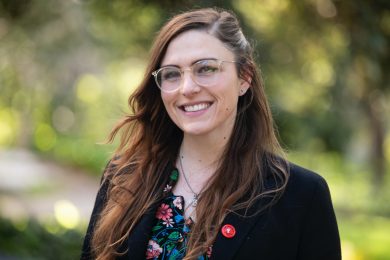
Jessica Calvanico is a PhD Candidate in the Feminist Studies Department at UC Santa Cruz, with designated emphases in Visual Studies and Critical Race and Ethnic Studies. In her own words, Calvanico’s research “considers how histories of sexuality, race, and class converge to create a carceral system of girlhood by exploring the historical foundations of the juvenile justice system in the United States South.” With a special focus on New Orleans, her work aims to expand our understanding of the relationship between the carceral state and girlhood.
In May, we spoke with Calvanico to learn more about her work and research interests. This year, she was selected as THI’s Year-Long Dissertation Completion Fellow. In our interview with Calvanico, we discussed her time as a fellow and the scope of her dissertation.
Congratulations on your Year-Long Dissertation Fellowship Jessica! To begin, perhaps you can tell us a bit about yourself. What is your academic background? And how did you come to be interested in your specific field?
Thank you so much! My intellectual biography is a bit circuitous, but all the twists were really important for binging me to my current field. As an undergraduate, I studied anthropology. I went to school in D.C. and while there, I interned at Smithsonian Folkways Recordings, which piqued my interest in the blues and Americana music. Following this, I received a departmental undergraduate research grant to do fieldwork on blues tourism in the Mississippi Delta and spent a summer in Clarksdale, interviewing folks who made “pilgrimages” to important sites across the Delta. This early research experience affirmed my interest in the ways gender, race, and class shape the consumption and circulation of cultural histories of the U.S. South.
My work attends to these intersectional legal histories to understand how the subject category of the girl is not only limited by the law, but perpetually surveilled and punished through it.
After that, I did my master’s at University of Chicago, which is where I started to fall in love with semiotics and queer theory. I was particularly interested in the ways gender and sexuality shape/are shaped by cultural practices within homosocial space. As I began exploring homosociality, I became more focused on carceral institutions as state-sponsored homosocial space and turned my focus back to the U.S. South, specifically to New Orleans.
In broad strokes, can you give us a general idea of your area of research? How does your work intervene in the current state of legal history, or perhaps the study of carcerality more generally?
I am interested in the ways the law limits the possibilities of subjecthood. In my research, I explore this by tracing the legal history of U.S. girlhood and its relationship to the criminal justice system. While there have been studies that examine the historical emergence of girlhood and the juvenile justice system, very little attention has been paid to intersectional legal histories of girlhood. My work attends to these intersectional legal histories to understand how the subject category of the girl is not only limited by the law, but perpetually surveilled and punished through it.
You’ll be using the opportunity of being a THI Fellow to work toward completing your Dissertation, titled: “Carceral Girl Problems: The House of the Good Shepherd and the Making of New Orleanian Girlhood.” Can you tell us a bit about what you hope to do in this project? What’s the core argument or idea of this particular work?

300 Block of North Broad Street, Sanborn Fire Insurance Map, 1896. Louisiana Division/City Archives & Special Collection, New Orleans Public Library.
My dissertation considers the House of the Good Shepherd in New Orleans—a Catholic reformatory for “sexually delinquent” girls. The House of the Good Shepherd was quite unusual in the Jim Crow South, because it admitted all girls regardless of their race, ethnicity, class, nationality, language, or religion. I am particularly interested in the way this institution serves as a case study for what I call the carcerality of girlhood, or the figurative and literal forms of captivity, limitations, and restrictions placed on girls’ bodies. More specifically, I examine the House of the Good Shepherd as a carceral response to the “girl problem”—the national moral panic over the increased participation of girls in the public sphere during the turn of the twentieth century. Drawing on visual culture, folklore, film, music, legal documents, and asylum records, I analyze legal, social, visual, and historical constructions of “the girl” in late nineteenth and early twentieth century New Orleans to understand how the “the girl problem” paved the way for carceral girlhood.
This year you were selected as the 2020-2021 THI Dissertation Completion Fellow. To be sure, COVID has complicated everyone’s plans, but what have you been working on and thinking about over this year? How has having this source of support facilitated the completion of your dissertation?
I spent most of the year working on my dissertation and am happy to report that it is complete! I am currently in the final edit phase and preparing for my defense in June. In addition to wrapping up my dissertation, I am also serving as a peer mentor for the Graduate Student Success Program. Over the past two years, I have also been working with the Center for Innovations in Teaching and Learning (CITL) to develop the curriculum for a workshop series on “Teaching Disciplinary Writing.” This past winter, I co-facilitated the workshop series with CITL Associate Director for Graduate Programs, Kendra Dority.
I am honored to have been selected as the 2020-2021 THI Dissertation Completion Fellow and am incredibly grateful for the support. Not only has the fellowship been indispensable in allowing me the time to compile, organize, and analyze my archival materials, but it has also helped me learn how to enjoy the writing process and develop what I hope is an ongoing daily writing practice. Many thanks to THI!